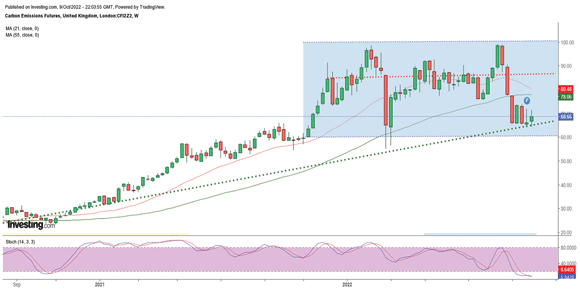By Frank O. Brannvoll, Brannvoll ApS, Denmark
European carbon emissions were up eight per cent in the first three quarters of 2022 when compared to 2021. This is based on the sharp increase in coal- and oil-driven power production.
The political debate of repowering the EU and the potential selling of 250m allowances has been hanging over the market.
Increased auctions and the lower production seen in several industries, combined with several speculators going short, kept the market in a tight EUR64-72 range.
Several sectors are seen selling their excess allowances to raise cash – for other margin payments or simply the purchase of energy.
The EUA December 2022 price trades at EUR69 and is now testing support in the range of EUR65-80, down due to political uncertainty and overall recession fear.

EUA front-year contract, September 2020-October 2022
The outcome of price emergency measures to be introduced by the EU will have an impact. The new adjustment of the EU ETS is still being discussed in the European Council, the Commission and the European Parliament for the 4Q, including:
• increase in the linear reduction factor (LRF) to 4.2 from 2.2 per cent from 2024
• reduction of 177m allowances in 2024
• keep the Market Stability Reserve (MSR) intake at 24 per cent, not reducing it to 12 per cent in 2024
• phase out free allowances by introducing the carbon border adjustment mechanism (CBAM) between 2026-35
• introduction of trading scheme for Transport and buildings from 2025-27.
For 2023 Brannvoll ApS sees a trading range of EUR60-100, with an average of EUR85, which almost equals last year’s forecasts.
